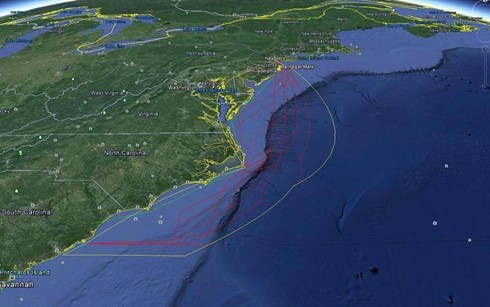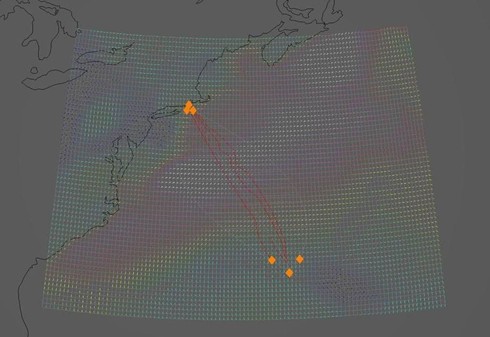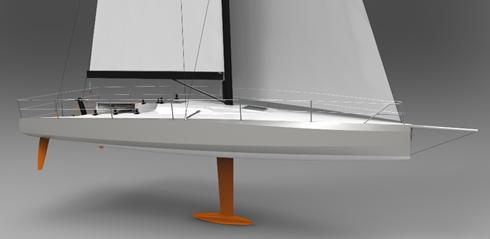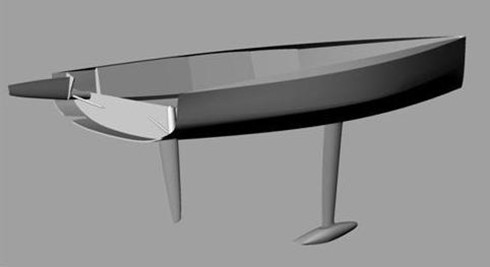This is a short report used in response to enquiries for medium size IRC yachts. The work is based on the hull development and weather/routing analysis undertaken for our latest Class 40 project and how it relates and is transferable to our custom IRC 36 and IRC 401 designs.
Class 40 OCD179 - IRC OCD 401 joint report - July 1 st 2014
Ourselves and Clay Oliver completed the hull design of our latest Class 40 a month ago and sent the lines to the yard to begin construction. Briefly, as part of determining both the final hull and ballast tank arrangement OCD developed over two dozen new hull models which had a range of longitudinal centers of buoyancy, waterline beam, wetted surface area etc. We then compared these both in inshore windward-leeward, Olympic triangle courses and offshore conditions using 12 years of weather data from Chris Bedford and modelling in Router .
For the purposes of the Class 40 we looked at two offshore races, the Atlantic Cup and Bermuda Race, using twelve years of high resolution weather data for the US east coast from Florida to Nova Scotia. There is no limit to the courses that can be set however, OCD have run models for other projects on courses as diverse as Sydney-Hobart and Fastnet

Atlantic Cup Leg 1, 2006, optimum routes, over seven race starts on different days either side of day one
The Atlantic Cup was chosen because the course is generally almost 100% inside the Gulf Stream, in lighter airs, that sets the most challenging kind of test for twin rudder hull designs, particularly whenever there are the downwind conditions. The Bermuda race of course is different, crossing the stream into warmer (and usually higher wind speed) conditions, cutting across the prevailing winds almost at 90 degrees. An ideal race for this hull type targeting footing and reaching performance. We could easily have looked at upwind performance in offshore conditions by choosing a suitable course in Router, north to south. However this performance parameter was covered by an analysis that took in Olympic and windward leeward courses in wind speeds up to 30 kts.
The results were somewhat of a surprise in terms of average weather. Of course there were very large annual variations, with from memory at least one year when our software selected no water ballast at all for the Class 40s and race times were in excess of 80 hours, whereas the average passage time was 66 hours, there were no passage times under 60 hours. We can pull out individual wind angles and wind speeds from the measured data (this is not forecast data) and the numbers below are a very very concise summary of some significant numbers that were found.
There was no surprise to find that inside the Gulf Stream, on average almost 50% of the distance sailed was completed in wind speeds of 10 knots or less, nor that 50% of that racing was at true wind angles greater than 130 TWA. What was surprising however was that at least 25% of the racing was undertaken in wind speeds of 16kts or more. The numbers for the Bermuda Race were higher than the Atlantic Cup, as one would expect but again proportionally more than we and sailors we’ve discussed the race with would have expected perhaps.
| Atlantic Cup Leg 1 | | | | |
| | | | | |
| % of distance spent in 10kts TWS or less | 47.4 | % |
| % of distance spent in 16kts or more | 25.0 | % |
| Distance spent sailing at >130 TWA | 49.6 | % |
| Bermuda Races | | | | |
| | | | | |
| % of distance spent in 10kts TWS or less | 40.8 | % |
| % of distance spent in 16kts or more | 28.9 | % |

Wind field graphics over Eastern seaboard and optimal routes, 4 boats on the Bermuda Race, single year
The result of this in hull selection terms is that when the first of our new designs were compared to our datum boats (which included the existing low wetted surface narrower than max beam generation #2 Class 40s Dragon and Cutlass), in all except the lightest of the downwind races/years, the more powerful boats were quickest. I’m not saying the most powerful, but certainly boats that were well up the range in terms of wetted surface area and waterline beam were quickest over the courses in the average conditions.
The instructions from the client for the Class 40 was that he wanted the fastest boat for inshore courses, but was willing to sacrifice some upwind performance in a trade off for light airs performance downwind in order to win races such as the Atlantic Cup, Marblehead-Halifax. He also wanted to perform well in the Bermuda Race but would accept the fact that in ‘windy years’ European Class 40’s that are designed for trans-oceanic courses might be faster. Our target however was always to push the envelope at the higher end as much as possible to be competitive with the more powerful boats in moderate airs while maintaining superiority in predominant light to moderate conditions prevalent on the east coast.
Below there is part of a BIN report that shows the average wind range over the 2001 Bermuda race as it would have been experienced by one of our datum boats. The box shows the number of miles sailed compared to the true wind speed (top axis) and the true wind angle (left hand axis).
| Twa/Tws | 2 | 4 | 5 | 6 | 7 | 8 | 9 | 10 | 12 | 14 | 16 | 20 | 25 | Sum | Twa-% |
| 32 | | | | | | | 0.1 | 4.1 | 14.4 | 24.5 | 6.8 | 0.6 | | 50.5 | 7.5 |
| 36 | | | | | | 0.8 | 2.9 | 7.5 | 10.0 | 10.6 | 3.4 | 0.2 | | 35.3 | 5.3 |
| 40 | | | | 0.7 | 0.5 | 1.5 | 4.3 | 6.2 | 8.4 | 9.3 | 5.5 | 1.8 | | 38.2 | 5.7 |
| 45 | 0.2 | 1.8 | 6.8 | 5.0 | 3.7 | 5.4 | 8.9 | 5.7 | 11.0 | 11.5 | 4.0 | 2.7 | | 66.7 | 9.9 |
| 52 | 0.3 | 5.0 | 10.9 | 8.2 | 5.7 | 1.8 | 2.9 | 4.4 | 4.4 | 8.7 | 4.3 | 1.4 | | 58.0 | 8.6 |
| 60 | 0.3 | 4.1 | 9.7 | 11.7 | 13.1 | 7.1 | 8.2 | 11.8 | 10.0 | 6.9 | 9.3 | 1.2 | | 93.4 | 13.9 |
| 70 | 2.8 | 6.0 | 6.4 | 10.0 | 6.6 | 2.1 | 2.9 | 12.0 | 10.0 | 4.6 | 7.6 | 0.7 | | 71.7 | 10.7 |
| 80 | 1.3 | 4.9 | 5.1 | 3.9 | 4.6 | 5.2 | 2.7 | 3.8 | 10.0 | 9.3 | 4.5 | 1.0 | | 56.4 | 8.4 |
| 90 | 0.0 | 2.0 | 4.3 | 3.0 | 2.4 | 3.5 | 4.3 | 4.1 | 0.1 | 0.2 | 1.6 | 3.9 | 0.5 | 29.8 | 4.4 |
| 100 | 4.7 | 9.2 | 4.8 | 1.6 | 2.0 | 1.0 | 2.9 | 3.0 | 0.1 | 2.3 | 1.6 | 1.4 | 0.0 | 34.5 | 5.1 |
| 110 | 2.0 | 3.7 | 3.2 | 3.3 | 0.4 | 0.5 | 0.7 | 1.7 | 2.5 | 3.6 | 1.9 | 1.2 | 0.0 | 24.8 | 3.7 |
| 120 | 0.2 | 1.0 | 0.5 | 2.3 | 0.9 | 2.0 | 1.7 | 1.2 | 4.9 | 1.9 | 2.3 | 0.4 | 0.0 | 19.4 | 2.9 |
| 130 | | | 0.5 | 1.6 | 3.5 | 2.2 | 2.9 | 3.4 | 2.0 | 0.8 | 1.6 | 0.2 | 0.0 | 18.8 | 2.8 |
| 140 | | | 0.1 | 1.2 | 2.4 | 0.0 | 0.7 | 5.7 | 9.2 | 8.2 | 3.1 | 4.3 | 0.3 | 35.3 | 5.3 |
| 150 | | | | 0.4 | 0.8 | 0.0 | 0.8 | 6.6 | 12.9 | 4.8 | 0.3 | 7.2 | 1.8 | 35.6 | 5.3 |
| 160 | | | | | | | | 0.3 | 1.9 | 0.3 | | | | 2.6 | 0.4 |
| 170 | | | | | | | | | | | | | | 0.0 | 0.0 |
| 180 | | | | | | | | | | | | | | 0.0 | 0.0 |
| Sum | 11.9 | 37.8 | 52.3 | 53.0 | 46.7 | 33.2 | 47.1 | 81.3 | 111.9 | 107.5 | 57.7 | 28.1 | 2.6 | 671.0 | Miles |
| Tws-% | 1.8 | 5.6 | 7.8 | 7.9 | 7.0 | 4.9 | 7.0 | 12.1 | 16.7 | 16.0 | 8.6 | 4.2 | 0.4 | 100.0 | |
179 MH Base File V2 Polars 2001 All Legs True Wind bins of total distance
One of the interesting points we can take from this is the numbers in red which show the distances sailed with water ballast (ie the boat is fully and consistently powered up), which can be summarised as follows:
| Water ballast | |
| | | | |
| Miles sailed | 146.5 | miles | |
| % Route | | 21.8 | % | |
By the end of six weeks of analysing in what conditions and why different designs were quickest we were indeed able to fulfil all our goals and develop a yacht which was the fastest on the inshore/offshore courses, the Atlantic Cup, and was able to beat, the most powerful design, albeit narrowly in all the years from 2001 to 2012. The new design is quick in the light, making it to the new breeze at the edge of the Gulf Stream first and just quick enough in the stronger breeze that is a feature of some years that there’s not enough time for the more powerful designs to catch up before the Bermuda finish.
IRC 401 Offshore OCD 4 th Generation Class 40
What does this signify for an IRC 36 and IRC401 design? Well it does seem to confirm that the average wind direction and wind strength exists to support the design of an IRC yacht of moderate righting moment and wetted surface area inshore of the Gulf Stream in races that are 50% downwind and in light airs, as well as one might have expected, in the Bermuda Race. In short, while light airs is a dominant factor, by careful optimisation of hull, appendage and rig factors one can develop a yacht that is reasonably quick in light airs, but is optimised for what are actually the total mean conditions experienced on the US east coast. Of course, we’ll want to carry out more work on the IRC hull forms, both narrow, low righting moment and the more moderate higher righting moment ones, but it would seem that as in Europe it will be possible to create an inshore/offshore yacht with a competitive advantage over the current crop of narrow waterline single rudder one design class boats.
 |  |
IRC 401 Inshore OCD 4 th Generation Class 40
In terms of the hull design one can see some of the difference between our European modelled IRC401 and the Class 40 developed for the US. Two of the most obvious differences if one looks closely is that in the new boat the chine is both higher and has almost disappeared except for amidships, replaced by a softer, rounded hull form that results in lower wetted surface area when heeled. The higher chine, reduced upright wetted surface, but when fully heeled the yacht is still max beam allowed in the Class 40 rule and takes advantage of the volume created by the chine amidships.
There are a number of areas where Class 40 design doesn’t cross-over easily into IRC because the geometry and characteristics of a Class 40 (too light, too wide, sail area to displacement ratio too high and draft) step over the limits of the rating algorithm producing penalties that don’t allow these kind of boats to correct out well against ‘normal’ IRC boats over a range of conditions and courses.
However we’were able to show in our article in Seahorse published in Dec 2012, as well as describing the findings on our website here how these effects can be mitigated by good design practice producing a very competitive IRC boat, one with much of the outright performance and handling characteristics of the short-handed forty footers. The development of a hull based on our fourth generation Class 40 work ( New OCD Class 40 for 2015 ) is and example of another aspect of the development work we've undertaken that improves the performance of IRC designs over an even wider range of conditions than we had first thought.
To discuss either IRC design or weather analysis further contact: Merfyn Owen
